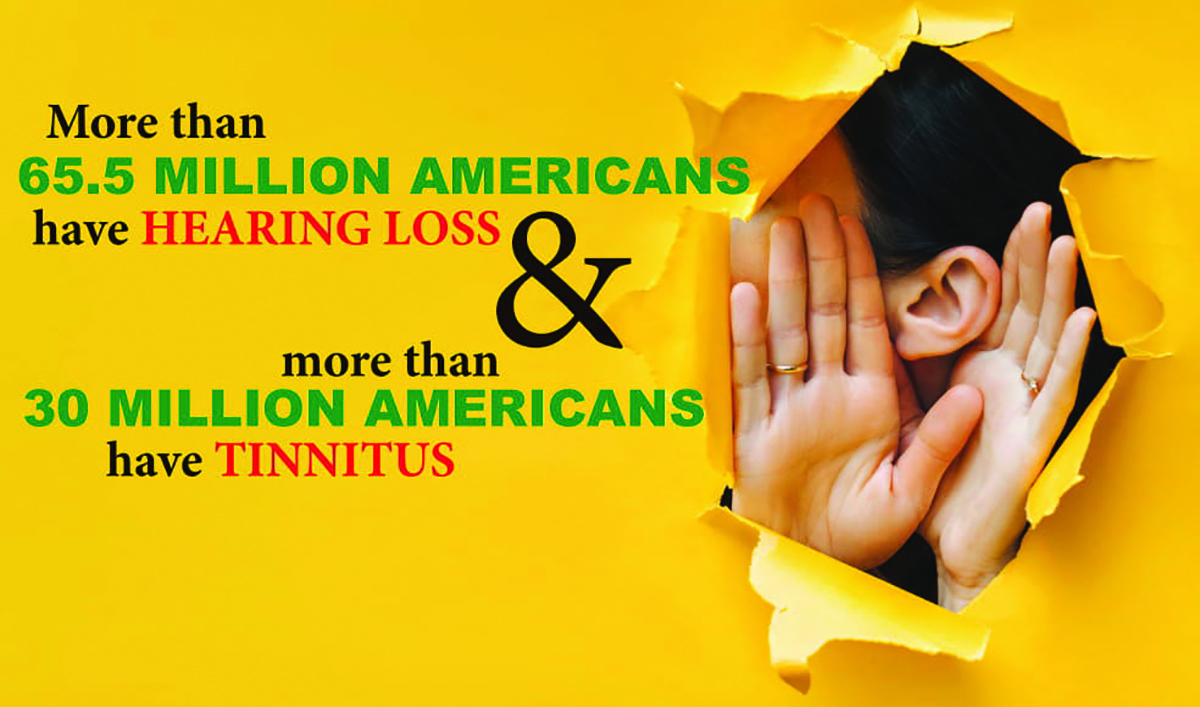How widespread is hearing loss?
Dr. Whitney Smith, one of the 12 audiologists that makes up the team of hearing professionals at Johnson Audiology, said, "More than 20% of the United States population is affected by various types and degrees of hearing loss. That's more than 65.5 million people! Additionally, tinnitus, which is a constant or intermittent ringing, buzzing, or hissing in the ears, affects more 30 million Americans." Recent research has come out which states that up to 13 million Americans without any degree of hearing loss also experience some form of tinnitus. Through medical conditions, noise exposure, genetic conditions, or the processes of aging, hearing loss can occur gradually or suddenly at any stage of life. The inner ear, or cochlea, is composed of thousands of small hair-like fibers responsible for sending hearing signals to the brain. One of the leading causes of hearing loss in people under the age of 40 is due to noise exposure, which can cause major damage to the inner ear leading to hearing loss and tinnitus.
What is hidden hearing loss?
Dr. Johnson said, "For most people with hearing issues, a basic hearing test, also called an audiogram, reveals, in a very obvious way, the type and severity of a person's hearing loss." Sometimes damage done to the inner ear, either by noise exposure or auto-immune disorders, is not so transparent though. Dr. Johnson mentioned that in some cases "damage can create a 'hidden hearing loss' where the hearing test shows normal hearing, but tinnitus or difficulty hearing in a noisy environment is still a concern." This damage causes an incomplete signal being sent to the brain, which can lead to a familiar hearing complaint where a person knows that something is being said but cannot understand the actual words. The repeated noise exposure causes a breakdown of the hearing system in a way that is not detectable by a standard hearing test; however, the damage can cause enough inner hair fibers to be destroyed, which leads to the sensation of tinnitus but with a lack of detectable hearing loss. Dr. Smith said, "With a hidden hearing loss, the brain is still able to process simple sounds resulting in the appearance of 'normal hearing,' but more difficult sounds like conversational speech can be harder for the brain to process. As a result, communication often fails." Long-term exposure to noise, even in small amounts, has been shown to be one of the leading causes of hidden hearing loss and tinnitus.
Why is hidden hearing loss something to be concerned about?The frustration a person feels when dealing with hidden hearing loss and tinnitus can lead to social isolation and a decrease in social interactions. Also, because hidden hearing loss is more difficult to diagnose, it may be overlooked, a person's complaints and struggles minimized, and their frustration grows. A university-trained audiologist is the professional most equipped and skilled to recognize when a person might be struggling with hidden hearing loss and to initiate the expanded testing that is necessary for diagnosis. A standard hearing test with additional noise testing can help to identify the degree of difficulty a person is having in noisy situations. Speech in noise testing, which includes repeating sentences as the volume of background noise increases, can be done to help determine the amount of difficulty someone is experiencing when processing sound with background noise present. Dr. Johnson urged, "When visiting your audiologist, it is important to relay all symptoms related to your hearing and balance. This will help your audiologist pick the correct tests and formulate an appropriate treatment plan." Important symptoms to relay if hidden hearing loss may be a concern include:
often hearing speech incorrectly
feeling like you are struggling when listening in environments when background noise is loud, but you understand people well in quiet situations
constant tinnitus, or
feeling distracted, or even anxious, in difficult listening environments.
Advancements in technology make the difference
Dr. Smith said, "Treatment for hidden hearing loss continues to develop, and research has shown that around 60% of patients with tinnitus say they experience some relief from their symptoms while wearing hearing aids." It also has been proven that the improvements in directional microphones of hearing aids have helped to overcome communication breakdowns in noisy situations. The advances in noise reduction in hearing aids have developed to help overcome the volume of noise and help to focus attention on the important conversations with loved ones. Dr. Johnson said, "Over the course of my 19-year career as an audiologist, I have seen such advancements in technology. These advancements are what have made the detection and treatment of hidden hearing loss possible. It can be a real game changer for people."
Knowledge about the structure and workings of the inner ear continues to progress, and a better understanding of how damage to the inner ear creates different types and degrees of hearing loss continues to develop. Additionally, hearing technology and treatment for hearing loss is advancing by leaps and bounds. "At no other time in history have we been more informed and more equipped to help people with all types of hearing loss," said Dr. Smith. "Take control of your hearing loss. Take action today."

